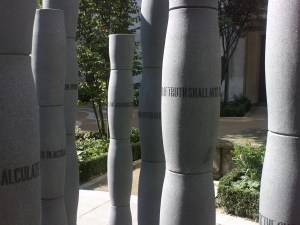J & I came across this sculpture when we were going to Freewheel the other week. In fact, I was just taking a short cut to Sainsburys. I don’t think I would have seen it otherwise.
I was absolutely amazed when I discovered what it was all about – all the the more intriguing when I discovered why it was here, and not anywhere else, where it could be seen better.
For me, I think it was very moving. In fact, it feels to me ‘what a sculpture should be about’. It tells us a very important part of our history, even how it was ‘accepted’ in the past as the ‘norm’ and how ‘ the norm’ was challenged – and how the minority won. Sometimes it is important to ‘challenge the mainstream’ and here is a great success story, even though it took years to abolish the Slade Trade.
It also gives the souless, ‘fat cat’ country of the City a ‘Heart’ in London. Sometimes, ethnics is more important than tons of money. We all leave footprints behind, and we should be conscious of this.
For me, it adds extra meaning. For one thing, I used to work in ‘commodities’ and if the Slave Trade would have continued, maybe we would have still dealt with ‘slave’ and not just the cocoa we were bringing into this country. (Actually, I would have refused to work there!) Secondly, one of my relatives (Irish) was a plantation owner in the East Coast of America and his wife was an abolitionist and anti slave trade journalist, who was born in the UK. (It wasn’t just Wilberforce who was involved in the Anti Slave Trade Movement.)
To think that years and years after her death, London has finally provide us with a sculpture in memory of the End of the Slave Trade, which makes us think to the past and to the future and to remember what were like once.
I found the sculpture incredibly moving, although it would have been nicer (more publicity perhaps) to have it where everybody could easily see it, but still, there was a very good reason why it was there, and perhaps that adds an extra poignancy to it. I thought the sculpture was very well thought out.
J thought the poles could be ‘slaves’ or ‘sugar cane’. Indeed, the sculpture could be ‘read’ in many ways.
I think this also makes a good Critical Mass place to visit, particularly as Black History Month is in October and everyone needs to see this. .
To add my own relative’s comments (she has a plaque in the US but not in the UK). Written by Fanny Kemble, in 1863 in Philadelphia. She used to write to her friend Elizabeth because her husband didn’t let her talk about abolishing the trade. This comes from her journal ‘Journal of a Georgian Plantation’:-
“You know very well dear E——, that in speaking of the free blacks of the North I here state nothing but what is true and of daily experience. Only last week I heard, in this very town of Philadelphia, of a family of strict probity and honour, highly principled, intelligent, well-educated, and accomplished, and (to speak the world’s language) respectable in every way—i.e.
rich. Upon an English lady’s stating it to be her intention to visit these persons when she came to Philadelphia, she was told that if she did nobody else would visit her; and she probably would excite a malevolent feeling, which might find vent in some violent demonstration against this family.”
This gives you an idea of how much pressure there was to not get involved with the Movement. You would be ostracised.
Now, about this new London statue:-
Published: 05/09/2008 (by an online paper)
UNVEILED: Archbishop Desmond Tutu reveals the sculpture, Gilt of Cain, to mark the bicentenary of the abolition of slavery
ARCHBISHOP Desmond Tutu unveiled a memorial yesterday (4 Sep) to mark the bicentenary of the abolition of the transatlantic slave trade.
The sculpture, Gilt of Cain, was designed by Kirriemuir artist Michael Visocchi and made by Aberdeenshire-based Bon Accord Granite.
It stands in Fen Court in the City of London, close to St Mary Woolnoth Church, where the Rev John Newton delivered his anti-slavery sermon that inspired William Wilberforce in the 18th century.
The sculpture is a group of columns around a podium, which suggests both a pulpit and an auctioneer’s platform.
A poem called the Guilt of Cain written by Lemn Sissay appears across it, weaving the language of the Stock Exchange with Old Testament biblical references.
The archbishop was joined by a crowd of at least 100 well-wishers as he unveiled the statue.
He said: “It is an amazing monument and it combines so many messages: the pulpit, the church, and the site where trading took place.”
Mr Visocchi, 31, who now lives in Edinburgh, said he was “deeply touched” that the archbishop had seen his work and said he felt the event was “a real part of history”.
The sculpture was built in partnership with Black British Heritage.
“It’s a way to help all people understand the nature of the slave trade. It’s a symbol of reconciliation and reflection that will create calm and remind everyone that the slave trade still exists today and we must try to destroy it.”
City of London planning and transportation committee chairman Christine Cohen said: “Fen Court has a direct connection to the history of the slave trade.
“It was here in the 18th century that John Newton, himself an escaped slave, encouraged and advised William Wilberforce, the great campaigner for the abolition of slavery.
“The City is also where shipping and trading of commodities took place and, in past times, both of these were connected with slave transport.
“It is therefore fitting that this monument should be situated here.”




You must be logged in to post a comment.